Darkly handsome British film and television actor Richard Greene (1918-1985) was a matinee idol of the late 1930s who appeared in more than 40 films. He was perhaps best known for the lead role in the long-running British TV series The Adventures of Robin Hood (1955-1960).
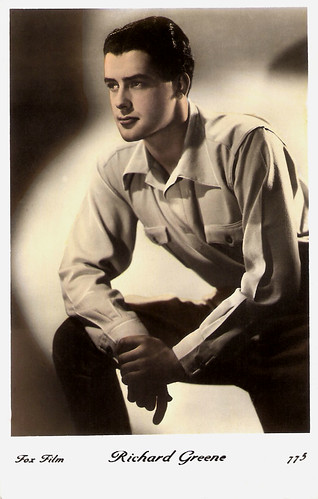
French postcard, no. 775. Photo: Fox Film.

French postcard by Viny, no. 89. Photo: 20th Century Fox.
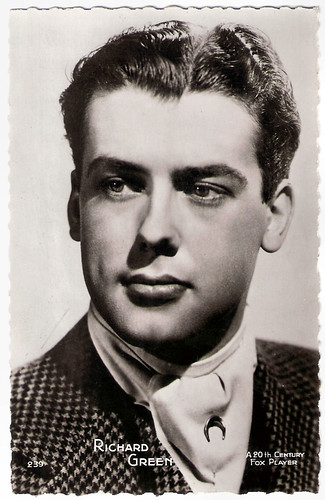
French postcard by Editions P.I., offered by Les Carbones Korès, no. 239. Photo: 20th Century Fox.

French postcard by Viny, no. 107. Photo: 20th Century Fox.
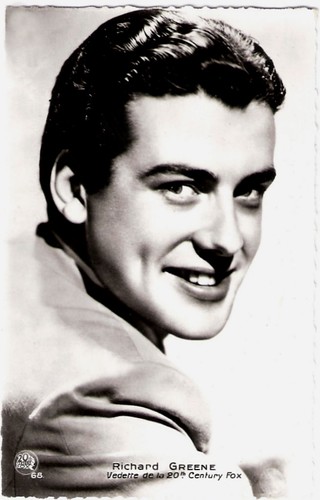
French postcard by Edit. Chantal, Rueil, no. 68. Photo: 20th Century Fox.
Richard Marius Joseph Greene was born in the port city of Plymouth, Devon, England, in 1918 (some sources say 1914). He was a descendant of four generations of actors. His father, Richard Abraham Greene and his mother, Kathleen Gerrard, were both actors with the Plymouth Repertory Theatre. His aunt was the musical theatre actress Evie Greene and his grandfather was film pioneer William Friese-Greene.
Greene was educated at the Cardinal Vaughn School in Kensington, where he left at the age of 14. He became determined to pursue the acting profession, making his stage debut in 1933 as a spear carrier in a production of William Shakespeare's 'Julius Caesar'. He was an exceedingly good-looking young man with an athletic build, dark wavy hair, and a pleasant speaking voice. He added to his income by modelling shirts and hats.
He played a small role in a 1934 revival of the play 'Journey's End' and a bit part in the British musical film, Sing As We Go (Basil Dean, 1934), but the scene was deleted from the final version. In 1936, Greene joined the Brandon Thomas Company and learned his trade in repertory. He won accolades in the same year for his leading part in Terence Rattigan's 'French Without Tears', which brought him to the attention of a talent scout from 20th Century Fox.
At 20, he signed a seven-year contract and went to Hollywood as a rival to MGM's Robert Taylor. The studio added 4 years to his age in all publicity materials. His first film for Fox was John Ford's Four Men and a Prayer (1938), in which he played the youngest of four British brothers in search of evidence to clear their disgraced colonel father (C. Aubrey Smith).
Greene was a huge success, especially with female filmgoers who sent him mountains of fan mail which at its peak rivalled that of Fox star Tyrone Power. Greene played a banker's son turned horse trainer in the popular horse breeding epic, Kentucky (David Butler, 1938) opposite Loretta Young, a college student estranged from his alcoholic father in Here I Am a Stranger (Roy Del Ruth, 1939), and steamboat inventor Robert Fulton in the fanciful historical drama Little Old New York (Henry King, 1940) with Alice Faye. One of his most notable roles was Sir Henry Baskerville in the Sherlock Holmes film The Hound of the Baskervilles (Sidney Lanfield, 1939). The film also marked the first pairing of Basil Rathbone and Nigel Bruce as Sherlock Holmes and Dr. Watson.
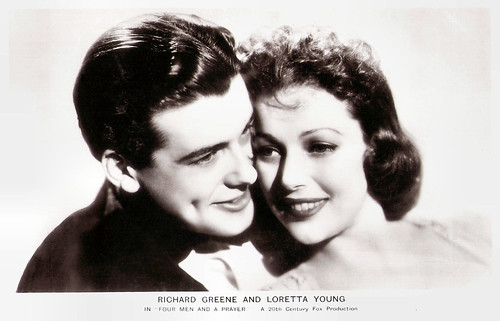
British postcard in the Picturegoer Series, London, no. FS 163. Photo: 20th Century Fox. Publicity still for Four Men and a Prayer (John Ford, 1938) with Loretta Young.

British postcard in the Picturegoer series, London, no. 1317. Photo: 20th Century Fox. Publicity still for Here I am a Stranger (Roy Del Ruth, 1939).

British postcard by Real Photograph.

British postcard by Real Photogravure.
In 1940, at the peak of his popularity, Richard Greene interrupted his Hollywood career to return to his homeland to aid in the war effort: an admirable personal decision which would have negative professional consequences. Enlisting in the Royal Armoured Corps of the Twenty-Seventh Lancers, he distinguished himself throughout World War II eventually becoming a captain.
He was relieved from duty in 1942 to appear in the British Propaganda films Flying Fortress (Walter Forde, 1942) and Unpublished Story (Harold French, 1942) with Valerie Hobson.
In 1943, he appeared in the thriller The Yellow Canary (Herbert Wilcox, 1943) with Anna Neagle while on furlough. He later toured in George Bernard Shaw's Arms and the Man, entertaining the troops. Greene was discharged in December 1944 and appeared in the stage plays Desert Rats and I Capture the Castle.
After the conflict ended, Greene and his young bride, beautiful British actress Patricia Medina (whom he had married in 1941) remained in England for a time where both appeared on stage and in British films. Richard's pictures included the charming comedy, Don't Take It to Heart (Jeffrey Dell, 1944), and the disappointing biopic about the Irish theatre entrepreneur George Howard, Gaiety George (George King, Leontine Sagan, 1946).
In 1946 Greene (accompanied by Medina who'd been offered a Fox contract) returned to Hollywood to complete his contract with 20th Century Fox. When his dreams of regaining his lost momentum did not materialize, he opted to take whatever film work he could find. After landing a solid supporting role in the wildly popular costumer, Forever Amber (Otto Preminger, 1947), he found himself cast in a series of swashbuckling roles, the most memorable of which was The Black Castle (Nathan Juran, 1952) in which the heroic Greene battled Bela Lugosi and Boris Karloff.

Latvian postcard by J.D.A., Riga, no. 3058. Photo: 20th Century Fox.
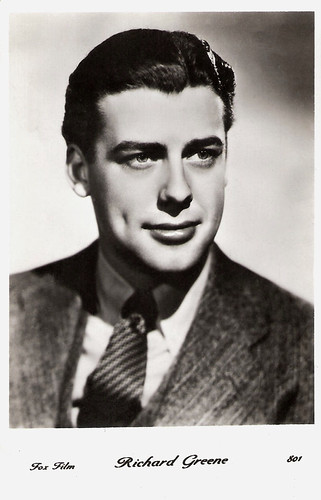
French postcard, no. 801. Photo: Fox Film.

Dutch postcard. Photo: London Films. Publicity still for That Dangerous Age (Gregory Ratoff, 1949) with Peggy Cummins.
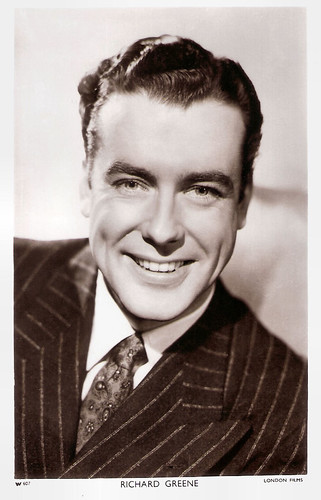
British postcard in the Picturegoer Series, London, no. W 607. Photo: London Films.
Richard Greene turned away from filmmaking in favour of the theatre and television. During the early 1950s, he had a long love affair with Nancy Oakes, the wealthy daughter of mining tycoon Sir Harry Oakes. In 1951 their daughter Patricia Louise was born in Mexico City, while Greene was still married to Patricia Medina. Greene divorced from Medina a few months later.
By the mid-1950s, his career was in decline. He had lost money on a play, 'The Lost Tent', which failed to reach the West End. He was disillusioned and cash-strapped when the British company Yeoman Films approached him in 1955. They offered him to play the legendary Robin of Locksley in The Adventures of Robin Hood, a series aimed at the American market.
The still youthful-looking Greene eagerly signed on and was an immediate success. The Adventures of Robin Hood ran for 143 half-hour episodes from 1955 to 1960. Some of the episodes were directed by the young Lindsay Anderson. It made Greene a major television star and solved his financial problems.
In 1960 he married Columbian heiress Beatriz Robledo-Summers. When The Adventures of Robin Hood ended they pursued together many of his hobbies including travelling, sailing, and breeding champion horses. In the 1960s and 1970s Greene appeared less and less interested in acting, only occasionally accepting roles in mostly forgettable action adventures and horror films, such as The Blood of Fu Manchu (Jesus Franco, 1968) and Tales from the Crypt (Freddie Francis, 1972). His TV work included episodes of The Professionals (1978) and Tales of the Unexpected (1979).
His second marriage ended in divorce in 1980. Two years later Richard Greene suffered serious injuries in a fall followed by a diagnosis of a brain tumour. In the autumn of 1982, he underwent brain surgery from which he never fully recovered. Richard Greene died of cardiac arrest in 1985 in Norfolk, England. His daughter Patricia Leigh-Wood continued the theatrical tradition – she studied drama at Vassar College, New York. Her daughter Shirley Alice Leigh-Wood (1985) is an actress and dancer, who works under the stage name Shirley Oakes.
Trailer The Little Princess (1939). Source: Video Detective (YouTube).
Trailer for The Hound of the Baskervilles (1939). Source: Video Detective (YouTube).
Trailer for Lorna Doone (1951). Source: Buyout Footage Historic HD Film Archive (YouTube).
Leader of The Adventures of Robin Hood (1955-1960). Source: buzzzz1964 (YouTube).
Sources: Dan Van Neste (IMDb), Anna Fraser and Lucy Carpenter (Robin Hood TV - now defunct), Los Angeles Times, Wikipedia and IMDb.
This post was last updated on 12 July 2024.

French postcard, no. 775. Photo: Fox Film.

French postcard by Viny, no. 89. Photo: 20th Century Fox.

French postcard by Editions P.I., offered by Les Carbones Korès, no. 239. Photo: 20th Century Fox.

French postcard by Viny, no. 107. Photo: 20th Century Fox.

French postcard by Edit. Chantal, Rueil, no. 68. Photo: 20th Century Fox.
Exceedingly good looking
Richard Marius Joseph Greene was born in the port city of Plymouth, Devon, England, in 1918 (some sources say 1914). He was a descendant of four generations of actors. His father, Richard Abraham Greene and his mother, Kathleen Gerrard, were both actors with the Plymouth Repertory Theatre. His aunt was the musical theatre actress Evie Greene and his grandfather was film pioneer William Friese-Greene.
Greene was educated at the Cardinal Vaughn School in Kensington, where he left at the age of 14. He became determined to pursue the acting profession, making his stage debut in 1933 as a spear carrier in a production of William Shakespeare's 'Julius Caesar'. He was an exceedingly good-looking young man with an athletic build, dark wavy hair, and a pleasant speaking voice. He added to his income by modelling shirts and hats.
He played a small role in a 1934 revival of the play 'Journey's End' and a bit part in the British musical film, Sing As We Go (Basil Dean, 1934), but the scene was deleted from the final version. In 1936, Greene joined the Brandon Thomas Company and learned his trade in repertory. He won accolades in the same year for his leading part in Terence Rattigan's 'French Without Tears', which brought him to the attention of a talent scout from 20th Century Fox.
At 20, he signed a seven-year contract and went to Hollywood as a rival to MGM's Robert Taylor. The studio added 4 years to his age in all publicity materials. His first film for Fox was John Ford's Four Men and a Prayer (1938), in which he played the youngest of four British brothers in search of evidence to clear their disgraced colonel father (C. Aubrey Smith).
Greene was a huge success, especially with female filmgoers who sent him mountains of fan mail which at its peak rivalled that of Fox star Tyrone Power. Greene played a banker's son turned horse trainer in the popular horse breeding epic, Kentucky (David Butler, 1938) opposite Loretta Young, a college student estranged from his alcoholic father in Here I Am a Stranger (Roy Del Ruth, 1939), and steamboat inventor Robert Fulton in the fanciful historical drama Little Old New York (Henry King, 1940) with Alice Faye. One of his most notable roles was Sir Henry Baskerville in the Sherlock Holmes film The Hound of the Baskervilles (Sidney Lanfield, 1939). The film also marked the first pairing of Basil Rathbone and Nigel Bruce as Sherlock Holmes and Dr. Watson.

British postcard in the Picturegoer Series, London, no. FS 163. Photo: 20th Century Fox. Publicity still for Four Men and a Prayer (John Ford, 1938) with Loretta Young.

British postcard in the Picturegoer series, London, no. 1317. Photo: 20th Century Fox. Publicity still for Here I am a Stranger (Roy Del Ruth, 1939).

British postcard by Real Photograph.

British postcard by Real Photogravure.
Swashbuckling roles
In 1940, at the peak of his popularity, Richard Greene interrupted his Hollywood career to return to his homeland to aid in the war effort: an admirable personal decision which would have negative professional consequences. Enlisting in the Royal Armoured Corps of the Twenty-Seventh Lancers, he distinguished himself throughout World War II eventually becoming a captain.
He was relieved from duty in 1942 to appear in the British Propaganda films Flying Fortress (Walter Forde, 1942) and Unpublished Story (Harold French, 1942) with Valerie Hobson.
In 1943, he appeared in the thriller The Yellow Canary (Herbert Wilcox, 1943) with Anna Neagle while on furlough. He later toured in George Bernard Shaw's Arms and the Man, entertaining the troops. Greene was discharged in December 1944 and appeared in the stage plays Desert Rats and I Capture the Castle.
After the conflict ended, Greene and his young bride, beautiful British actress Patricia Medina (whom he had married in 1941) remained in England for a time where both appeared on stage and in British films. Richard's pictures included the charming comedy, Don't Take It to Heart (Jeffrey Dell, 1944), and the disappointing biopic about the Irish theatre entrepreneur George Howard, Gaiety George (George King, Leontine Sagan, 1946).
In 1946 Greene (accompanied by Medina who'd been offered a Fox contract) returned to Hollywood to complete his contract with 20th Century Fox. When his dreams of regaining his lost momentum did not materialize, he opted to take whatever film work he could find. After landing a solid supporting role in the wildly popular costumer, Forever Amber (Otto Preminger, 1947), he found himself cast in a series of swashbuckling roles, the most memorable of which was The Black Castle (Nathan Juran, 1952) in which the heroic Greene battled Bela Lugosi and Boris Karloff.

Latvian postcard by J.D.A., Riga, no. 3058. Photo: 20th Century Fox.

French postcard, no. 801. Photo: Fox Film.

Dutch postcard. Photo: London Films. Publicity still for That Dangerous Age (Gregory Ratoff, 1949) with Peggy Cummins.

British postcard in the Picturegoer Series, London, no. W 607. Photo: London Films.
The legendary Robin of Locksley
Richard Greene turned away from filmmaking in favour of the theatre and television. During the early 1950s, he had a long love affair with Nancy Oakes, the wealthy daughter of mining tycoon Sir Harry Oakes. In 1951 their daughter Patricia Louise was born in Mexico City, while Greene was still married to Patricia Medina. Greene divorced from Medina a few months later.
By the mid-1950s, his career was in decline. He had lost money on a play, 'The Lost Tent', which failed to reach the West End. He was disillusioned and cash-strapped when the British company Yeoman Films approached him in 1955. They offered him to play the legendary Robin of Locksley in The Adventures of Robin Hood, a series aimed at the American market.
The still youthful-looking Greene eagerly signed on and was an immediate success. The Adventures of Robin Hood ran for 143 half-hour episodes from 1955 to 1960. Some of the episodes were directed by the young Lindsay Anderson. It made Greene a major television star and solved his financial problems.
In 1960 he married Columbian heiress Beatriz Robledo-Summers. When The Adventures of Robin Hood ended they pursued together many of his hobbies including travelling, sailing, and breeding champion horses. In the 1960s and 1970s Greene appeared less and less interested in acting, only occasionally accepting roles in mostly forgettable action adventures and horror films, such as The Blood of Fu Manchu (Jesus Franco, 1968) and Tales from the Crypt (Freddie Francis, 1972). His TV work included episodes of The Professionals (1978) and Tales of the Unexpected (1979).
His second marriage ended in divorce in 1980. Two years later Richard Greene suffered serious injuries in a fall followed by a diagnosis of a brain tumour. In the autumn of 1982, he underwent brain surgery from which he never fully recovered. Richard Greene died of cardiac arrest in 1985 in Norfolk, England. His daughter Patricia Leigh-Wood continued the theatrical tradition – she studied drama at Vassar College, New York. Her daughter Shirley Alice Leigh-Wood (1985) is an actress and dancer, who works under the stage name Shirley Oakes.
Trailer The Little Princess (1939). Source: Video Detective (YouTube).
Trailer for The Hound of the Baskervilles (1939). Source: Video Detective (YouTube).
Trailer for Lorna Doone (1951). Source: Buyout Footage Historic HD Film Archive (YouTube).
Leader of The Adventures of Robin Hood (1955-1960). Source: buzzzz1964 (YouTube).
Sources: Dan Van Neste (IMDb), Anna Fraser and Lucy Carpenter (Robin Hood TV - now defunct), Los Angeles Times, Wikipedia and IMDb.
This post was last updated on 12 July 2024.
I was a big fan of this Robin Hood series, in fact I think it was one of the first shows I ever saw on TV. It came on early in the morning, and then I'd go out with the neighborhood kids and we'd pretend to fight the evil Sheriff of Nottingham :)
ReplyDelete